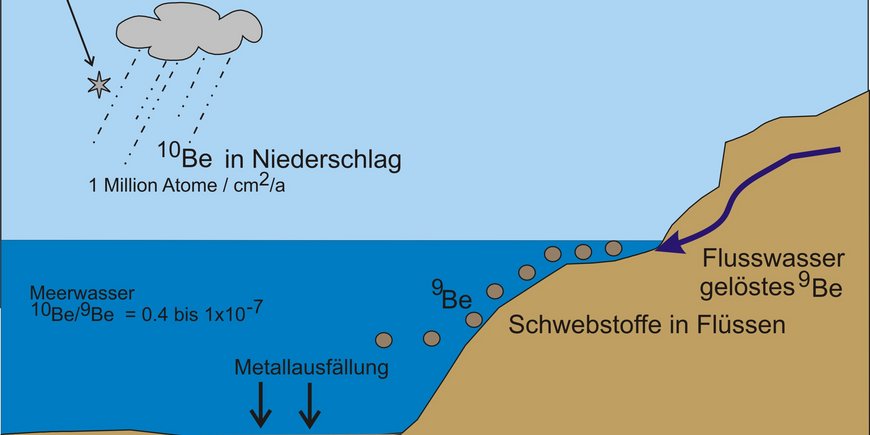The explanation for accelerated sedimentation in the past 5 million years
12.05.2010 | Potsdam: The constant increase in the volume of accumulated sediment that has taken place in the past 5 million years does not exist. This is the principle result of an analysis that GFZ scientists Jane Willenbring and Friedhelm von Blanckenburg publish in the newest issue of the Journal “Nature” (13.May 2010). The globally observed four-fold acceleration of sedimentation is an artifact of the observations. Important geological hypotheses that are based on this observation now require revision.
Erosion by water and ice, and chemical weathering of rocks of the Earth’s surface lower mountains over millions of years. The rock eroded is now found in sediment. Measurements of the thickness of sediment deposited globally in oceans and on the continents surrounding large mountains has resulted in the finding that the amount of sediment that is deposited per unit of time has continuously risen in the past 5 million years. To produce this additional sediment, mountains need to erode with similarly accelerated rates
Hypotheses for the cause of this phenomenon have assumed the increased global growth of mountains by movement of tectonic plates which resulted in accelerated erosion. But the opposite has also been suggested: the mountains existed long before the observed increase, but only a shift in global climate like the onset of the ice age ~3 million years ago accelerated erosion of the mountains which in turn rose be removing this weight. To date neither of these hypotheses, however, was explained by satisfactory geologic processes.
Carbon dioxide and the weathering of rocks
But they lead to a further paradox that, to date, Geoscientists failed to resolve. Reconstructions of the past concentrations of the greenhouse gas carbon dioxide (CO2) in the atmosphere by indirect chemical and biological methods have shown that in the past 10 million years these hovered around approximately that amount that the atmosphere contained prior to the current rapid increase in CO2 concentrations. If erosion increases globally, so would the chemical decay of rocks. Rock weathering requires carbonic acid contained in rain and hence permanently consumes small amounts of atmospheric CO2. The amount consumed balances exactly that emitted annually into the atmosphere through volcanoes. Over millions of years nature uses this mechanism to stabilise the greenhouse effect on Earth and hence Earth’s temperature. Had the withdrawal of CO2 indeed been many times higher by the accelerated weathering, the atmosphere would not contain significant amounts of CO2 anymore. Earth would be extremely cold and all water would be frozen.
Beryllium 9 and the preservation of sediments
The GFZ-scientists Jane Willenbring and her collegue Friedhelm von Blanckenburg have now solved this riddle. They found that the increase in sedimentation rates is a so-called “artifact” of the observations: the more detail geologists observe, the more sediment they discover. In younger geologic time the observations get better than those made on sediment millions of years in age. This is so because not all sediment, once deposited, survives the passage of geologic time. The increase in sedimentation therefore is not real – it merely mirrors the better preservation of younger sediment.
As support for this new interpretation, Willenbring and von Blanckenburg use geochemical measurements in certain ocean deposits. In centimeter-thick iron-manganese crusts, that grow deep in the oceans extremely slowly over millions of years, the history of input of erosion products into the oceans is disclosed by changing metal concentrations. The scientists have used the isotope of the mass 9 of the rare element beryllium. This element is supplied into the oceans from erosion through rivers. Should the erosion have increased, we would find more Beryllium-9 in the younger layers of the crusts.
Beryllium 10 is the witness
As a control for this effect Willenbring and von Blanckenburg have also used the extremely rare isotope Beryllium-10. This isotope is generated in the atmosphere by cosmic rays and is deposited through rain in equal amounts into the oceans, where it is incorporated into the crusts in also equal amounts per time during their growth. Variations of the ratio of Beryllium-10 to Beryllium-9 are hence only due to variations in erosion of the continents. This ratio as measured in many crusts throughout the oceans has indeed remained unchanged in the past 10 million years.
Only one conclusion is possible: the erosion of the continents was stable over the past few Million years, an acceleration has never taken place. A fundamental geologic assumption has so been undone, but a big scientific mystery has also been resolved.
J.K. Willenbring und F. von Blanckenburg, „Long-Term Stability of Global Erosion Rates and Weathering During Late-Cenozoic Cooling”, Nature, Vol. 465, issue 7295, pp 211-214, doi: 10.1038/nature09044, 13.05.2010








![[Translate to English:] Torsten Sachs in front of a climate station on a field](/fileadmin/_processed_/3/9/csm__TorstenSachs_bearbeitet_GS_4a1365ef84.jpeg)

![[Translate to English:] left image flood at the Ahrtal: image from above, several houses are flooded; left image:: Heidi Kreibich;](/fileadmin/_processed_/4/4/csm_Bild2_9af0130e9f.png)



![[Translate to English:] Start der Vega Rakete](/fileadmin/_processed_/6/4/csm_20231201-kachel_Vega-VV23-launch_ESA-CNES-Arianespace_706716b68c.jpeg)









![[Translate to English:] Poster exhibition at the Brandenburg Hydrogen Day at the GFZ, some participants in the foreground](/fileadmin/_processed_/6/5/csm_Erster_Brandenburgischer_Wasserstofftag_GFZ_402fcec95e.jpeg)
![[Translate to English:] Group picture of the participants](/fileadmin/_processed_/9/4/csm_20231108_CAWa-Workshop-Tashkent_Gruppenbild_99ea779d8a.jpeg)

![[Translate to English:] [Translate to English:] Hörsaal](/fileadmin/_processed_/e/6/csm_H%C3%B6rsal_e21ac645fb.jpeg)


![[Translate to English:] The Delegations in the Historic Library on the Telegrafenberg. In the back there are from left to right, the Dutch Ambassador for Germany, Ronald van Roeden, the Dutch Minister for Education, Culture and Science, Robbert Dijkgraaf and the scientific director of the GFZ, Susanne Buiter.](/fileadmin/_processed_/d/b/csm_Kachel-2_9eba4b4212.jpeg)

